Electronics and Communication Engineering - Exam Questions Papers
Exercise : Exam Questions Papers - Exam Paper 4
- Exam Questions Papers - Exam Paper 12
- Exam Questions Papers - Exam Paper 22
- Exam Questions Papers - Exam Paper 21
- Exam Questions Papers - Exam Paper 20
- Exam Questions Papers - Exam Paper 19
- Exam Questions Papers - Exam Paper 18
- Exam Questions Papers - Exam Paper 17
- Exam Questions Papers - Exam Paper 16
- Exam Questions Papers - Exam Paper 15
- Exam Questions Papers - Exam Paper 14
- Exam Questions Papers - Exam Paper 13
- Exam Questions Papers - Exam Paper 1
- Exam Questions Papers - Exam Paper 11
- Exam Questions Papers - Exam Paper 10
- Exam Questions Papers - Exam Paper 9
- Exam Questions Papers - Exam Paper 8
- Exam Questions Papers - Exam Paper 7
- Exam Questions Papers - Exam Paper 6
- Exam Questions Papers - Exam Paper 5
- Exam Questions Papers - Exam Paper 4
- Exam Questions Papers - Exam Paper 3
- Exam Questions Papers - Exam Paper 2
11.
Find RAB
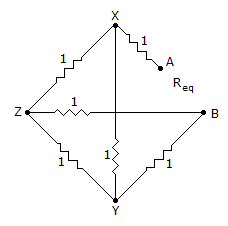

Answer: Option
Explanation:
By solving 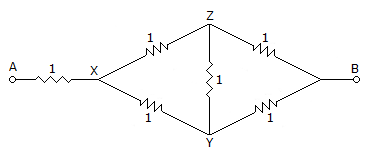
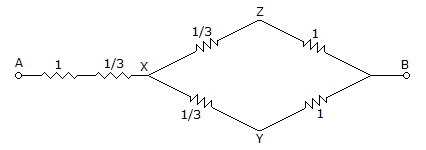


12.
For the network shown below, determine fHi and fHO, if, r0 = ∞, Cbe = 36 Pf, Cbc = 4 Pf, Cce = 1 Pf, Cwo = 8 Pf, Cwi = 6 Pf
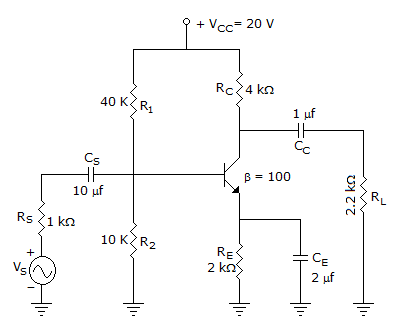
where Cwo = wiring capacitance at output side, Cwi = wiring capacitance at input side

where Cwo = wiring capacitance at output side, Cwi = wiring capacitance at input side
Answer: Option
Explanation:
Equivalent is

RTi = RS || R1 || R2 || Ri = 0.531 KΩ
Ci = Cwi + Cbe + (1 + AV)Cbc
= 6pf + 36pf + (1 - c - 90) 4 pf = 460 pf

RT2 = RC || RL = 4 K || 2.2 K = 1.419 KW
C0 = Cwo + Cce + CMO

13.
Complex pole in z-plane is as shown below. This is the pole diagram for __________ .
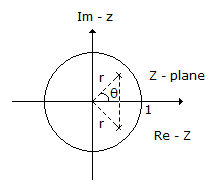

Answer: Option
Explanation:
Decaying sinusoidal sequence.
14.
Four messages band limited to W, W, 2W and 3W respectively are to be multiplex using Time Division Multiplexing (TDM). The minimum bandwidth required for transmission of this TDM signal is
Answer: Option
Explanation:
In TDM minimum bandwidth is twice the maximum frequency present. Thus, 6W is the answer.
15.
Which of the following terms are equivalent?
- A ⊕ B ⊕ C
- A ⊕ B ⊙ C
- A ⊙ B ⊕ C
- A ⊙ B ⊙ C
Answer: Option
Explanation:
A ⊕ B ⊕ C = A (B ⊕ C) + A(B ⊕ C)
= A(B ⊙ C) + A (B ⊙ C) = A ⊙ B ⊙ C
A ⊕ B ⊙ C = A (B ⊙ C) + A(B ⊙ C)
= A(B ⊕ C) + A(B ⊕ C)
= A ⊙ B ⊙ C.
Quick links
Quantitative Aptitude
Verbal (English)
Reasoning
Programming
Interview
Placement Papers

